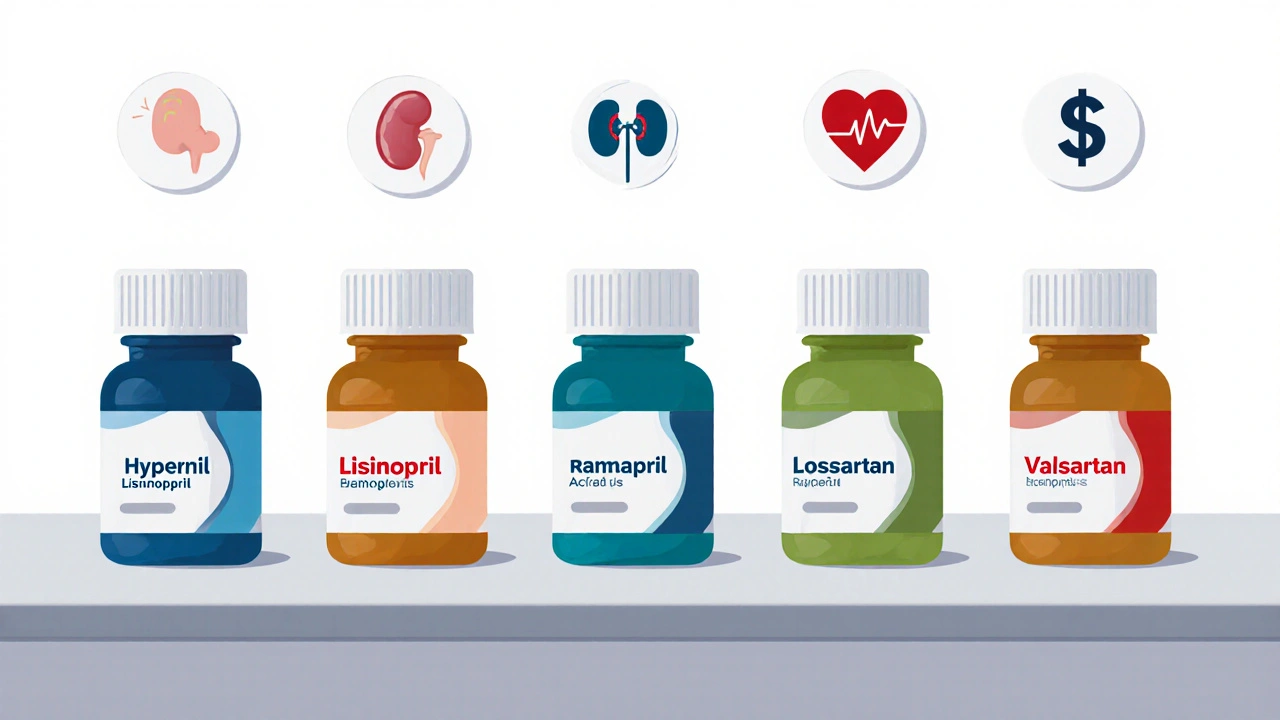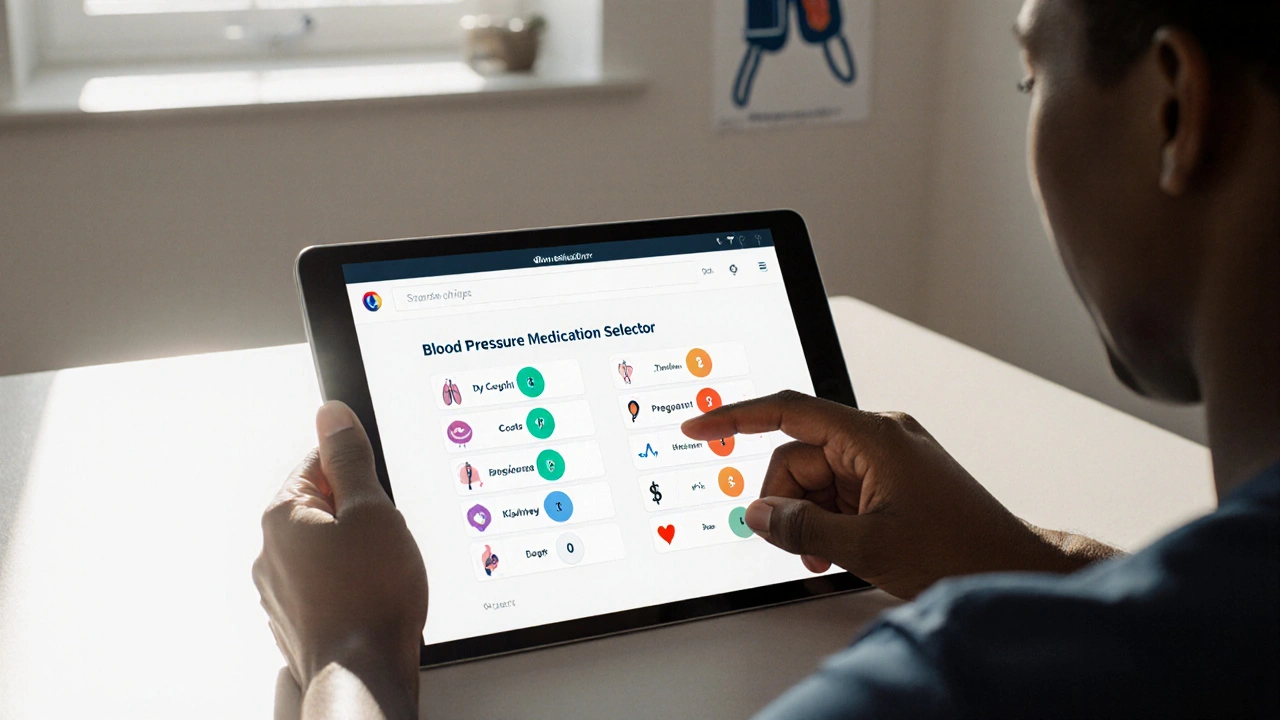Blood Pressure Medication Selector
Recommended Medication:
Key Benefits:
Important Considerations:
Key Takeaways
- Hypernil (lisinopril) is an ACE inhibitor that works for most people with high blood pressure, but it can cause cough for some.
- Enalapril and ramipril are similar ACE inhibitors with slightly different dosing schedules.
- Losartan and valsartan belong to the ARB class, which avoids the ACE‑inhibitor cough but may be pricier.
- Beta‑blockers like atenolol are useful when you need heart‑rate control, but they aren’t first‑line for hypertension alone.
- Choosing the right drug depends on kidney function, pregnancy status, side‑effect tolerance, and cost.
What is Hypernil?
Hypernil is a brand name for lisinopril, an ACE (angiotensin‑converting enzyme) inhibitor used to lower blood pressure and protect the heart. It works by relaxing blood vessels, making it easier for the heart to pump blood. Most doctors start patients on a 10mg daily dose and may increase to 40mg if needed. The drug is taken once a day, usually in the morning, and can also help with heart failure and kidney protection in diabetics.
How ACE inhibitors like lisinopril work
ACE inhibitors block the enzyme that converts angiotensin I to angiotensinII, a powerful vasoconstrictor. By reducing angiotensinII levels, blood vessels stay relaxed, blood pressure drops, and the heart faces less strain. This class also lowers aldosterone, which reduces fluid retention. The result is lower systolic and diastolic numbers, fewer heart‑attack risks, and slower progression of kidney disease.
Top alternatives to Hypernil
If lisinopril isn’t a good match, several other medications can do the job. Below are the most common options, each with its own pros and cons.
- Enalapril - another ACE inhibitor, often started at 5mg twice daily.
- Ramipril - ACE inhibitor favored for its once‑daily dosing and strong evidence in heart‑failure patients.
- Losartan - an ARB (angiotensinII receptor blocker) that avoids the classic ACE‑inhibitor cough.
- Valsartan - another ARB, similar to losartan but sometimes cheaper in generic form.
- Atenolol - a beta‑blocker useful when you need heart‑rate control alongside blood‑pressure reduction.
Side‑effect snapshot
Every drug comes with a side‑effect profile. ACE inhibitors (Hypernil, enalapril, ramipril) often cause a dry cough, elevated potassium, or rare angio‑edema. ARBs (losartan, valsartan) usually skip the cough but can raise potassium and cause dizziness. Beta‑blockers (atenolol) may lead to fatigue, cold hands, or sleep disturbances. Knowing which side effect you’re willing to tolerate helps narrow the list.

Cost considerations
Generic lisinopril (Hypernil) typically costs $4‑$10 for a 30‑day supply in the U.S., making it one of the most affordable options. Enalapril and ramipril sit in the same price range. Losartan and valsartan generics have dropped to $8‑$15 per month, but some insurance plans still favor ACE inhibitors. Atenolol is cheap, around $5 per month, but it’s not first‑line unless you have a specific heart‑rate issue.
Comparison Table
| Medication | Class | Typical Daily Dose | Common Side Effects | Average Monthly Cost (US) | Best For |
|---|---|---|---|---|---|
| Hypernil (Lisinopril) | ACE inhibitor | 10‑40mg | Cough, hyper‑kalemia, angio‑edema | $4‑$10 | General hypertension, kidney protection |
| Enalapril | ACE inhibitor | 5‑20mg (bid) | Cough, dizziness, rash | $5‑$12 | Patients needing split dosing |
| Ramipril | ACE inhibitor | 2.5‑10mg | Cough, taste disturbances | $6‑$13 | Heart‑failure and post‑MI patients |
| Losartan | ARB | 50‑100mg | Dizziness, hyper‑kalemia | $8‑$15 | Patients intolerant to ACE‑cough |
| Valsartan | ARB | 80‑160mg | Dizziness, fatigue | $9‑$16 | Similar to losartan, price‑sensitive |
| Atenolol | Beta‑blocker | 25‑100mg | Fatigue, cold extremities | $5‑$8 | Patients with arrhythmia or angina |
How to choose the right medication
Start by answering three quick questions:
- Do you experience a persistent dry cough on ACE inhibitors? If yes, an ARB like losartan might be smoother.
- Are you pregnant or planning pregnancy? ACE inhibitors and ARBs are contraindicated; a beta‑blocker or methyldopa is safer.
- Is cost a major factor? Hypernil, enalapril, and ramipril are usually the cheapest.
Next, consider kidney function. If your eGFR is below 30mL/min, doctors often lower ACE/ARB doses or switch to a different class. Finally, look at any other conditions-diabetes, heart failure, or a history of stroke-because some drugs (ramipril) have extra evidence for those scenarios.
Best‑fit scenarios
- Typical hypertension without special concerns: Hypernil is a solid first‑line choice.
- ACE‑inhibitor cough: Switch to losartan or valsartan.
- Heart‑failure or post‑MI: Ramipril has strong trial support.
- Pregnancy: Atenolol is generally avoided; methyldopa or labetalol is preferred.
- Severe kidney disease: Low‑dose ARBs may be safer, but close monitoring is essential.
Tips for talking to your doctor
- Bring a list of all current meds, including over‑the‑counter supplements.
- Note any side effects you’ve had with past blood‑pressure drugs.
- Ask about generic options and insurance coverage-most insurers favor Hypernil and enalapril.
- Discuss lifestyle measures (diet, exercise, sodium reduction) that can boost the drug’s effect.
- Request a follow‑up blood test in 2-4 weeks to check potassium and kidney function.
Frequently Asked Questions
Can I switch from Hypernil to an ARB without a doctor?
Never make the change on your own. Your doctor needs to check kidney function and potassium levels before swapping, because dosing differs between classes.
Why does Hypernil cause a cough?
ACE inhibitors increase bradykinin in the lungs, which irritates the airway and triggers a dry cough in about 5‑10% of users.
Is it safe to take Hypernil while drinking alcohol?
Moderate alcohol isn’t a direct contraindication, but both can lower blood pressure. Combining them may cause dizziness, so limit intake and monitor how you feel.
How long does it take for Hypernil to lower my blood pressure?
Most people see a drop within 1‑2 weeks, but the full effect can take up to a month. Your doctor will usually re‑check numbers after 4 weeks.
Can I take Hypernil with a potassium supplement?
Not without a doctor’s OK. ACE inhibitors already raise potassium, so adding a supplement can push you into dangerous levels.

Paige Crippen
October 4, 2025 AT 13:34They don't want you to know that the pharma giants push Hypernil because it lines their pockets, not because it's the safest choice.
sweta siddu
October 4, 2025 AT 15:14Wow, this guide is super helpful! 😊 It breaks down the options in a way that even my grandma could understand. 👍
Ted Mann
October 4, 2025 AT 16:54When you weigh the trade‑offs, think of the medication as a balance between efficacy and side‑effects, not just a price tag. The philosophy behind prescribing is about minimizing harm while maximizing quality of life.
Brennan Loveless
October 4, 2025 AT 18:34Honestly, the cheapest ACE inhibitor is often the best – you get decent control without the fancy bells and whistles that only drive up insurance premiums.
Vani Prasanth
October 4, 2025 AT 20:14True, cost matters a lot for many families, but we shouldn't ignore individual tolerability; a low‑cost drug that causes a cough can become a hidden expense.
Maggie Hewitt
October 4, 2025 AT 21:54Oh sure, because spending $15 a month on an ARB is the ultimate sacrifice when you could just swallow a $5 pill and hope for the best. 🙄
Shaquel Jackson
October 4, 2025 AT 23:34Meh, these tables are fine but I still prefer just guessing what works. 😒
Tom Bon
October 5, 2025 AT 01:14In summary, Hypernil (lisinopril) provides a cost‑effective first‑line option for most patients, while alternatives such as ARBs or beta‑blockers should be considered based on specific comorbidities and side‑effect profiles.
Clara Walker
October 5, 2025 AT 02:54Don't be fooled – those “summary” sections are often drafted by consultants with hidden stakes in the drug's market performance.
Jana Winter
October 5, 2025 AT 04:34First, the article correctly identifies that ACE inhibitors like Hypernil reduce angiotensin II levels, which leads to vasodilation. Second, it mentions the dry cough side‑effect, a well‑documented consequence of elevated bradykinin. Third, the cost analysis is accurate, showing generic lisinopril as one of the cheapest options. Fourth, the comparison table neatly aligns dosage ranges with typical indications. Fifth, the discussion on kidney protection aligns with current nephrology guidelines. Sixth, the safety profile for pregnancy is appropriately highlighted, noting contraindications. Seventh, the recommendation to monitor potassium is essential for any RAAS‑blocking therapy. Eighth, the article could improve by adding real‑world adherence data. Ninth, patient education on lifestyle modifications is mentioned but could be expanded. Tenth, the brief FAQ section addresses common concerns succinctly. Eleventh, the suggestion to follow up labs in 2‑4 weeks is standard practice. Twelfth, the mention of angio‑edema as a rare but serious risk is responsible. Thirteenth, the note about alcohol interaction is accurate though modest. Fourteenth, the piece omits discussion of combination therapy with diuretics, which many clinicians use. Fifteenth, overall, the guide offers a balanced overview while leaving room for deeper clinical nuance.
Linda Lavender
October 5, 2025 AT 06:14Ah, the symphony of pharmacology unfolds before our very eyes, each molecule dancing its delicate ballet upon the stage of the cardiovascular system, and yet we, humble observers, must decipher which pirouette shall best serenade our weary hearts while keeping the purse strings from trembling in terror.
Jay Ram
October 5, 2025 AT 07:54Great rundown! Keep the conversation going, and remember that staying active and eating right can amplify whatever medication you end up on.
Elizabeth Nicole
October 5, 2025 AT 09:34Exactly, combining lifestyle changes with the right prescription creates a powerful duo that can truly transform blood pressure numbers.
Dany Devos
October 5, 2025 AT 11:14The presentation is comprehensive, yet it would benefit from citing primary sources for each therapeutic claim.
Sam Matache
October 5, 2025 AT 12:54Yo, the vibe is solid but where's the meme that shows a heart doing the cha‑cha after you take Hypernil? 😂
Hardy D6000
October 5, 2025 AT 14:34Let's cut the fluff – no one needs a 20‑row table when a single sentence can tell you if a drug is right for you.
Amelia Liani
October 5, 2025 AT 16:14I hear you, but remember that patients often need that visual aid to truly grasp the differences between classes, especially when anxiety runs high.
shikha chandel
October 5, 2025 AT 17:54These meds are not a one‑size‑fits‑all.
Zach Westfall
October 5, 2025 AT 19:34the market pushes drugs like a tide and we just ride the waves
Pranesh Kuppusamy
October 5, 2025 AT 21:14Indeed, market forces play a role, yet clinical efficacy and patient safety must remain the paramount criteria when selecting antihypertensive therapy.